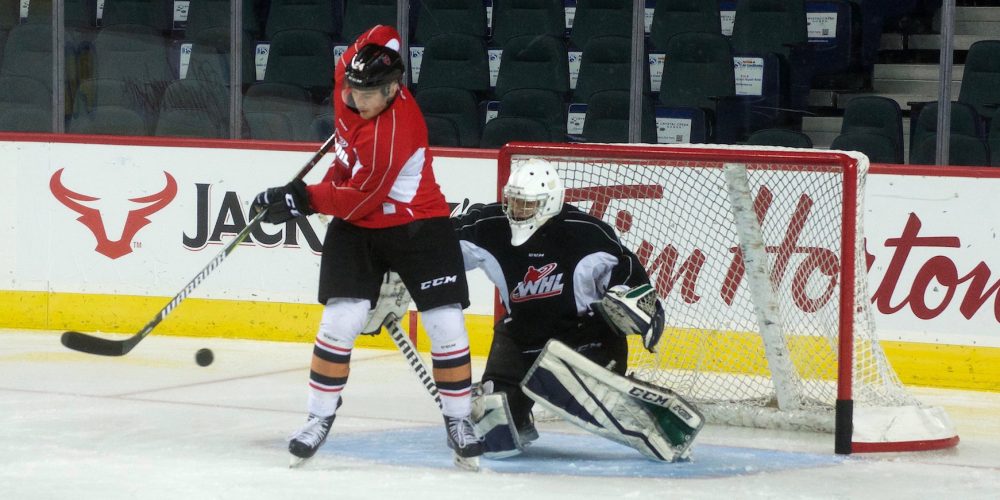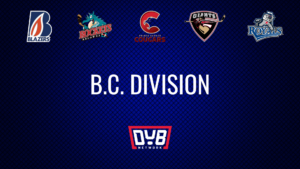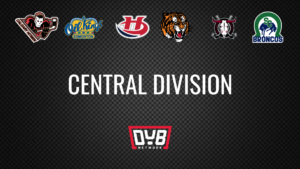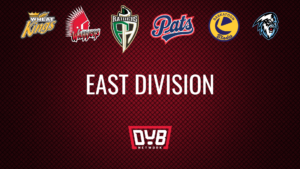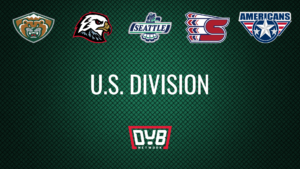Carl Stankowski could barely skate with the Ed Chynoweth Cup held high after he helped down the Regina Pats in six games during the 2017 Western Hockey League finals.
Despite barely being able to push off with his right leg, Stankowski backstopped the Seattle Thunderbirds to their first league title—in his 16-year-old season—after Rylan Toth went down with an injury towards the end of the regular season.
Experiencing that kind of success on that stage at such a young age tends to skyrocket a career, but not for Stankowski.
Not yet, at least.
Since hearing the final horn sound on a three-and-out trip to the Memorial Cup, Stankowksi has been doing everything in his powers just to return to the ice.
Returning home could help resurrect his career. At least that’s what he and the Calgary Hitmen are hoping for.
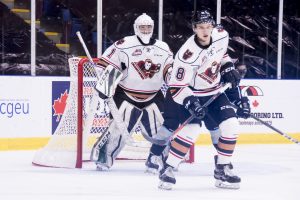
Late in the off-season, the Hitmen gave up the rights to 17-year-old U.S. prospect Mike Koster, an eight-round pick in the 2019 WHL Bantam Draft and a conditional fourth-round selection in either the 2019 or 2020 draft for the goaltender who didn’t play one second last season.
It is a homecoming for the netminder, who was born and raised in Calgary, coming of age through the local minor hockey levels.
Stankowski also played bantam triple-A with the Calgary Flames of the Alberta Major Bantam Hockey League where he turned into a WHL prospect after recording the third-best goals against average (1.88). That year he went 9-3-4 with a pair of shutouts and a .920 save percentage. Following the season, Stankowski picked up the bronze medal at the Alberta Cup with Team Calgary North after he dressed in four games and posted a glimmering 1.35 goals against and a .949 save percentage.
Those compiling of stats earned him the right to be the first goalie taken off the board when the Thunderbirds nabbed him with the 36thoverall pick in the second round during the 2015 WHL Bantam Draft.
“At the time, I was weighing my options between the NCAA and the WHL. After talking to a couple people and other players, the WHL seemed like the right fit,” said Stankowski. “Then when Seattle took me in the second round, the choice was easy.”
Following the draft, Stankowski was relocated to southern California, as his dad took a job in Anaheim. There, he suited up for the Anaheim Junior Ducks where again, he recorded spectacular numbers with a 1.87 goals against average and a .935 save percentage in 16 games.
California might not have offered the stiffest competition to prepare Stankowski for life in the WHL, but he was still named to the Thunderbirds roster the following season as a 16-year-old.
Life in the WHL can sometimes not be all that it’s cracked up to be, as he was stationed on the bench while overage netminder Toth carried the load.
“Being in the league is tough as a 16-year-old. You’re not playing as much as you would like,” said Stankowski. “When I got my chance, I tried my best to make it count.”
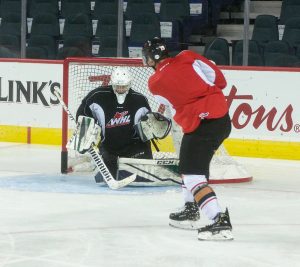
Early on, those chances were few and far between, as he only appeared in three games before November. Despite the limited action, Team Canada came calling and placed him on Team Red alongside current Hitmen centre Riley Stotts for the annual World U-17 Hockey Challenge.
Stankowski only appeared in two games for Team Red, went 1-1 but did make 19 saves in a 4-3 preliminary-round victory over the eventual champion Team Sweden.
That’s when everything changed—and not for the better.
“I started to feel some pain in my hip. I just tried to battle through it,” said Stankowski. “By the time the tournament ended, I couldn’t walk. I needed to find a way to get better if I was to be ready for playoffs.”
Unable to resume action with the Thunderbirds, Stankowski met with the team and determined that he needed a break. In the middle of the season, Stankowski left to get treatment in California, while fellow rookie netminder Matt Berlin filled in as backup and appeared in 13 games.
“Turned out, I had a torn labrum. When it was bad, I would get this nerve-type of shooting pain that was hit or miss. When it hurt, it hurt a lot,” said Stankowski.
Working with his personal physiotherapist Chris Watson, the pain subsided and the mobility was restored.
Stankowski made his return between pipes Feb. 24, more than four months after his last appearance Oct. 14.
Unfortunately, the pain wasn’t gone for good.
The second half was manageable as Stankowski returned to his spot working the gate. With only practices, warm-ups and two games since returning from Team Canada, the pain wasn’t that bothersome.
In a bittersweet twist of fate, Toth went down with a lower-body injury days before the playoff drive. Stankowski was thrust into the spotlight and the workload began to buildup on his right hip.
His body kept it together in the first round as the Thunderbirds disposed of the Tri-City Americans in four games.
The pressure of the playoffs didn’t seem to faze him and his right leg was hanging in there.
“I just kept going back to a cliché in my mind, ‘one puck at a time.’ I wasn’t focused on the other team, the stage of playoffs; I just focused on the next shot and stopping the puck,” said Stankowski.
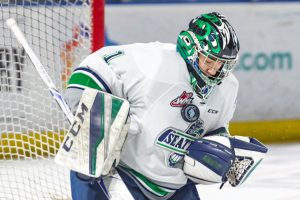
The Everett Silvertips threw everything at the Thunderbirds, but Stankowski didn’t waiver and picked up three one-goal victories through the first three games. Even when Stankowski yielded four goals in the second period of Game 3, he battled back and held the fort long enough for his captain Mathew Barzal to pot the winner in overtime.
But as the Thunderbirds swept their way through the first two rounds, the pain returned in Stankowski’s lower half.
“The pain came back in the Everett series. It got worse and worse each game, and by the time we were playing Regina, I was basically on one leg,” said Stankowski.
The Western Conference Final with the Kelowna Rockets tacked on extra miles, as they pushed the Thunderbirds to six games, but again, Stankowski didn’t waiver despite mounting pain.
Helping Stankowski make the improbable run was his trainer Watson, who made the trip from California for the tail end of the championship push, rehabbing the goaltender each night into the early-morning hours.
“If Chris didn’t come up for the finals, I’m not sure what I would have done. I just wanted to do whatever it took to keep playing, keep grinding and not make too much of a big deal about it,” said Stankowski.
Somehow, Stankowski kept it together and etched his named alongside Randy Petruk (Kamloops Blazers, 1994-95) and Dan Blackburn (Kootenay ICE, 1999-2000), as 16-year-old netminders to backstop a club to an Ed Chynoweth Cup.
Following Alexander True’s championship clinching goal in Game 6, Barzal said to WHL Communications Coordinator Taylor Rocca about his young netminder, “I’ve never seen a 16-year-old so focused and so prepared at all times. We told him going into overtime that, ‘We got you buddy. Make some big saves and we will get this one for you.’
“He’s been great for us and we couldn’t have asked for a bigger step up than what he did.”
Remarkably, Stankowski went 16-4 in the playoffs with two of those losses coming in overtime. His 1,222 minutes played more than doubled his regular season workload, as he registered a .911 save percentage and 2.50 goals against average.
After the adrenaline and elation wore off, the pain returned in a big way. So much so that Stankowski immediately returned to California to get extensive treatment done on his hip.
He didn’t even stick around for the championship parade.
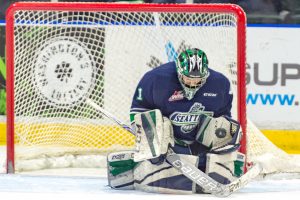
With five days off until puck drop at the Memorial Cup in Windsor, Ont., Stankowski and Watson did all they could to get ready, but operating at less than 100 per cent, the Thunderbirds didn’t show well at the tournament.
That summer, Stankowski went under the knife at Queen’s University in Ontario to repair a herniated disc in his spine, all while continuing his rehab on his hip.
While the hip eventually came around, Stankowski was still dealing with excessive, lingering inflammation from the surgery and the season was approaching.
“I wasn’t getting better and we weren’t sure why, so I went and got some blood tests done,” said Stankowski.
The tests came back positive for HLA-B27, a genetic marker for Ankylosing Spondylitis (AS), a rare autoimmune disease that presents itself as inflammatory arthritis.
“I guess when I was playing, the adrenaline would take over and I felt fine. Then, once I cooled down after the game, the pain usually came back,” said Stankowski. “It was frustrating to learn about the disease, but at least I finally knew what was going on.”
AS is commonly found in the sacroiliac joint, attacking the hips and lower back. The disease can lie dormant in the body for years. In some cases, it can be brought on by a traumatic event or collision. When it flares up, the disease can immobilize patients, as it is essentially the human body attacking itself. Stankowski still isn’t sure what triggered his case.
Currently, there is no cure for AS. But, with enough research, rehab and trial and error, Stankowski and his medical team have found ways to manage the arthritis.
“If I stick to a pretty strict sleep schedule and even stricter diet, I can minimize and manage the pain,” said Stankowski.
Certain foods increase inflammation in his body, so Stankowski had to take a chainsaw to his consumption habits. That meant no more sugars, no more carbohydrates, no more dairy, no more lectins and sadly, no more of his grandmother’s homemade Chinese food or perogies. These days, his go-to dish is beef (no sauce) and cauliflower.
As the fall turned into winter, Stankowski was coming along thanks to his ongoing rehab and willpower with his new diet.
There were plenty of carrots dangling in front of Stankowski to make a push at returning to the rink for the 2017-18 season.
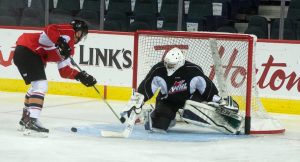
The Thunderbirds had a league title to defend and he was finally eligible for the National Hockey League Entry Draft.
Through the summer and into the start of the season, the Thunderbirds occasionally checked in on Stankowski, but the communication line was limited at best.
The Thunderbirds were approached for this story but declined to comment about Stankowski’s return to hockey.
By the time December rolled around, Stankowski’s body was becoming right again. But at that point in the season, he still needed a couple weeks to get in game shape, which would have seen him return to the lineup late in the season. He was also coming off the first pain-free stretch he had in months, so there was no way of knowing if the AS would immediately return or not.
With all that in mind, Stankowksi and his team decided to opt out of the rest of the season and focused on getting as healthy as possible for the following campaign.
“It was tough to sit out a whole year. I was watching the Thunderbirds a lot and they were having a pretty good season. It was also hard sit out my draft season,” said Stankowski. “I still think it was the right move and I am excited about the opportunity ahead of me now.”
That opportunity presented itself when Hitmen GM Jeff Chynoweth consulted with Stankwoski, his family, his physio team and the Thunderbirds, and eventually brought him back to the home Aug. 7 this past summer.
“Anytime a 16-year-old can lead his team to a Western Hockey League championship, you have to take notice. That is something that stuck in my mind,” said Chynoweth. “We didn’t have a lot of expectations for him this year, we were just hoping he could return to form and regain an opportunity to play in the Western Hockey League.”
The Hitmen had a big hole in the crease following last season, where they rode the 20-year-old Nick Schneider for a franchise record in minutes played.
This year, there was no clear-cut starter between the pipes for the Hitmen, so the opportunity was there for Stankowski to grab some minutes.
Chynoweth said at the time of the trade that he thought Stankowski was healthy and he expected him to be ready for the start of camp. To both their credit, Stankowski never missed an on-ice session or any dry-land training. From all accounts, he looked great again.
“We were super excited to see him on the ice again. Not playing for a whole season isn’t ideal, but you can see that the talent is there,” said Hitmen Goaltending Coach Jason LaBarbera. “He’s probably one of the more talented guys we’ve had here. Now, it’s just a matter of keeping him healthy and seeing what he is capable of.”
Stankowski was the best goaltender the Hitmen had in training camp and the pre-season, where went 2-0-0-0 in three games, played 120 minutes, stopped 78-of-81 shots for a remarkable .963 save percentage and 1.51 goals against average.
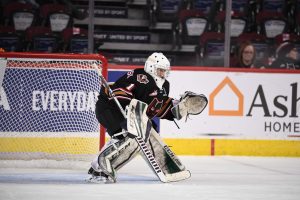
His strong play forced the hands of the Hitmen brass to reassign the 20-year-old netminder Nick Sanders, who they brought in at the trade deadline last year.
The left Stankowski, last year’s backup in Matthew Armitage and Jack McNaughton, a locally listed netminder fresh out of the midget triple-A ranks. (This past week, Armitage was reassigned to a team that has yet to be announced.)
Now that it appears Stankowski is going to play a big part in the Hitmen’s push to end their second-longest playoff drought in team history, communication is vital if they want to keep their goaltender on the ice.
“We have a pretty extensive email chain going on,” Hitmen Head Trainer Nathan Hollinger. “The biggest thing is keeping the lines of communication open between Carl, his family, our coaching staff, management and his trainers back home.
“All of us here are new to this disease, so we literally take it day-to-day. We base our treatment and our exercises off how Carl is feeling each day. If he feels great, we can push him a little bit more. If he isn’t feeling so good, we will rein it in. It’s really a trial and error thing at this point.”
Stankowski also has a pretty reliable source away from the rink to vent and discuss theories of puck-stopping, as he billets with David Marcoux, a former NHL goaltending coach for nine seasons, including six seasons with the Calgary Flames. If Stankowski enters an extended schneid for whatever reason, he has no problem bringing the issues home to have them ironed out.
It’s early, but Stankowski hasn’t gotten off to the greatest start after a dominant pre-season. Through three games, he’s played 179 minutes, sits 0-3-1-0 with a 4.53 goals against average and a .852 save percentage.
“I still have way more games played in the playoffs than in the regular season (in my WHL career),” joked Stankowski. “I just want to give the team a chance to win every night. If I can do that, then we should have a decent season.”
The numbers should come around along with the team’s play, but for right now, wins and losses aren’t as important.
“I didn’t know if I was going to play hockey ever again. It’s an awesome feeling and a blessing to be back on the ice with the boys. I’m really looking forward to this season and I hope I can show what I’m capable of.”

